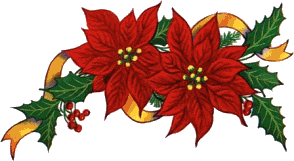



Christmas Plants
I
Ivy is perhaps the most well-known of Christmas symbols.
While many people would agree on this, not too many
could tell you its place in Christmas lore. The significance of ivy,
like holly and misletoe, is based on pagan rituals. Ivy was a symbol of
everlasting life in pagan religions. This hardy vine clings to the
smootherest of walls in the harshest weather. No matter how tough
the obstacle, the ivy perseveres. As such, ivy featured heavily in ancient
Celtic and Druid winter solstice rituals. The Celts and Druids thought that
just like ivy, the earth was everlasting and would persevere. It was a symbol of hope that spring would soon arrive. Ivy has the same meaning in Christian symbolism. It represents the everlasting life of Christ.
Holly is another Christmas decoration with pagan roots. In Celtic mythology, winter and summer were represented by twin kings, the "Holly King" (winter) the "Oak King" (summer). During autumn and early winter, the Holly King reigned supreme. The holly trees were the only greenery left in the bare forest. His twin,the Oak King, having lost his leaves, was 'naked' and therefore defeated. It is during this time that the days get shorter and shorter. However, during the Winter Solstice, the shortest day of the year, the balance of power between twins starts to shift. Once this day passes, the days begin to grow longer, gaining more light. Then it's the Oak King who reigns, only to be supplanted by his brother during the Summer Solstice. To the ancient Celts, this changing of the seasons was symbolic of the cycle of life, birth and death. Therefore, holly was symbolic of life and spring to come.
Poinsettia is a beautiful, red, star-shaped flower, the blooming season of
which coincides with the Christmas season. It is considered as one of the
favourite flowers of Christmas. The legend of the poinsettia came all the way
from Mexico. The ancient Aztecs (the rulinf tribe in Central Mexico at the time
of contact with Europe) prized the poinsettia as a symbol of purity. Centuries
later, Mexico's early Christians adopted the poinsettia as their prized Christmas
Eve flower. According to the Mexican tale a girl named Maria and her brother Pablo were very poor and couldn't buy any gifts for Baby Jesus in the manger at church. So they took some weeds and planted them all around the manger. However, the green top leaves of the weeds turned into bright red petals, and soon the manger was surrounded by beautiful star-like flowers and so we see them today. In some places, the poinsettia symbolises the 'Star' of Bethlehem.
The use of misletoe as a decoration has roots in bothpagan and Christian traditions. In pagan customs, enemies who met under misletoe were required to lay down their weapons and maintain a truce until the next day. The kiss component of this legend was the 'kiss of peace'. Among the Druids, misletoe was used during Winter Solstice ceremonies as a symbol of the eventual return of the sun. In Christianity, misletoe sprang into use in England during the middle ages.
The Christmas rose, also called the snow or winter rose, is a well-known
English plant which is traditionally regarded as a true Christmas flower
across Europe. It blooms in the depths of winter in the mountains of Central
Europe. The Christmas rose has an interesting legend. A young sheperd girl
named Madelon wanted to bring a gift to the Baby Jesus. But she was very
poor and had no money to buy an unusual gift. So she decided to gather a
simple bouquet of flowers. She searched the countryside for any herb, flower
or plant, but it was harsh winter ans there were none. In despair, Madelon
began to cry. An angel heard her cries and where Medelon's tears stained the
ground they caused beautiful, pure white roses to grow.









